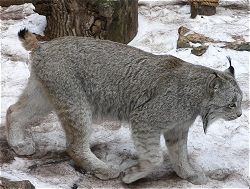Canada lynx epic journey

It would have been a fairy tale but for the ending. The hero is a Canada lynx known only by his identification number (specimen BC-03-M-02; a code name based on the cat's birthplace, year of capture, sex and ID number). After being transported to Colorado, this cat travelled an epic 2000 km back to his birthplace only to be trapped and killed north of Banff National Park in Alberta a few hundred kilometres from his original home territory.
The Canadian Lynx (lynx canadesis) is a medium-sized wild cat which weighs between 17 and 24 pounds (8 to 12 kg). It has distinctively long ear tufts and extra fur on the paws which spreads its weight allowing it to walk on soft snow. The cats feed on snowshoe hares. (see also Canada lynx (L. canadesis))
There is an ongoing project to reintroduce the species to the United States, where only about 200 of these cats remain. Lynx BC-03-M-02 was an involuntary part of that project. In 2003 he was trapped near Kamloops, British Columbia as part of the unique, bi-national effort to transplant lynxes from Canada to south-western Colorado. This is part of the Canadian lynx's original habitat where it had been extinct for decades. Re-populating this region has been a huge success, which U.S. wildlife officials have trumpeted as a model for the reintroduction of other extirpated species.
At the time of his capture, BC-03-M-02 was thought to be about 2 years old. He adapted well to his new environment near Silverton, Colorado. Between 2005 and 2007 he mated with a female who nurtured at least six healthy kittens to adulthood. But after that he vanished. The scientists in charge of the reintroduction project in Colorado believe that a decline in the number of snowshoe hares in the area caused the lynx to leave his Colorado habitat and head back home.
It is known that lynxes can travel long distances. There would be little remarkable in a report of a lynx travelling hundreds of kilometers. Even 1000 km is not unknown, but a 2000 km journey from Colorado to Alberta/BC border is definitely for the record books. This lynx must have travelled across a vast area of North America, over numerous mountain ranges and probably stretches of Colorado desert. This journey was only possible at all because of the Yellowstone-to-Yukon wildlife corridor project, which attempts to maintain a continuous area which allows animals to move across habitats, though few have used quite so much of the corridor as Lynx BC-03-M-02. Despite this long journey, the lynx was in good health when he reached Alberta.
The cat had an identification collar that read: 'PLEASE RETURN TO COLORADO FISH & WILDLIFE'. So when Rocky Mountain trapper Brian Anger found the animal in January 2010 he immediately contacted University of Alberta lynx researcher Gabby Yates. BC-03-M-02 had turned up dead, caught in one of his traps. The Canada lynx is not an endangered species in north-western Canada and it is legal in Canada to trap and hunt them. Brian Anger tries not to trap animals which are being used in research projects. He was horrified to discover that he was the cause of this heroic journey coming to its sad conclusion when the lynx was so close to home.
